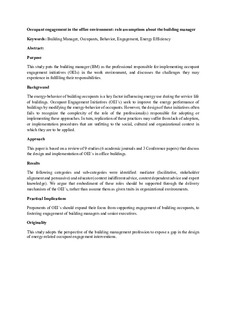| dc.contributor.author | Valle, Roberto | |
| dc.contributor.author | Boks, Casper | |
| dc.contributor.author | Berker, Thomas | |
| dc.date.accessioned | 2019-03-14T07:06:15Z | |
| dc.date.available | 2019-03-14T07:06:15Z | |
| dc.date.created | 2018-10-29T15:52:08Z | |
| dc.date.issued | 2018 | |
| dc.identifier.citation | Facilities. 2018, 36 (11/12), 584-599. | nb_NO |
| dc.identifier.issn | 0263-2772 | |
| dc.identifier.uri | http://hdl.handle.net/11250/2589915 | |
| dc.description.abstract | Purpose
This paper aims to put the building manager (BM) as the professional responsible for implementing occupant engagement initiatives (OEIs) in the work environment and discusses the challenges they may experience in fulfilling their responsibilities.
Design/methodology/approach
This paper is based on a review of nine studies (six academic journals and three conference papers) that discuss the design and implementation of OEIs in office buildings.
Findings
The following categories and sub-categories were identified: mediator (facilitative, stakeholder alignment and persuasive) and educator (context indifferent advice, context-dependent advice and expert knowledge). The authors argue that embodiment of these roles should be supported through the delivery mechanism of the OEIs, rather than assume them as given traits in organizational environments.
Practical implications
Proponents of OEIs should expand their focus from supporting engagement of building occupants to fostering engagement of BMs and senior executives.
Originality/value
This study adopts the perspective of the building management profession to expose a gap in the design of energy-related occupant engagement interventions. | nb_NO |
| dc.language.iso | eng | nb_NO |
| dc.publisher | Emerald | nb_NO |
| dc.title | Occupant engagement in the office environment: role assumptions about the building manager | nb_NO |
| dc.title.alternative | Occupant engagement in the office environment: role assumptions about the building manager | nb_NO |
| dc.type | Journal article | nb_NO |
| dc.type | Peer reviewed | nb_NO |
| dc.description.version | acceptedVersion | nb_NO |
| dc.source.pagenumber | 584-599 | nb_NO |
| dc.source.volume | 36 | nb_NO |
| dc.source.journal | Facilities | nb_NO |
| dc.source.issue | 11/12 | nb_NO |
| dc.identifier.doi | 10.1108/F-08-2017-0084 | |
| dc.identifier.cristin | 1624597 | |
| dc.description.localcode | © 2018. This is the authors' accepted and refereed manuscript to the article. The final authenticated version is available online at: https://doi.org/10.1108/F-08-2017-0084 | nb_NO |
| cristin.unitcode | 194,61,50,0 | |
| cristin.unitcode | 194,61,45,0 | |
| cristin.unitcode | 194,62,40,0 | |
| cristin.unitname | Institutt for arkitektur og planlegging | |
| cristin.unitname | Institutt for design | |
| cristin.unitname | Institutt for tverrfaglige kulturstudier | |
| cristin.ispublished | true | |
| cristin.fulltext | original | |
| cristin.qualitycode | 2 | |
